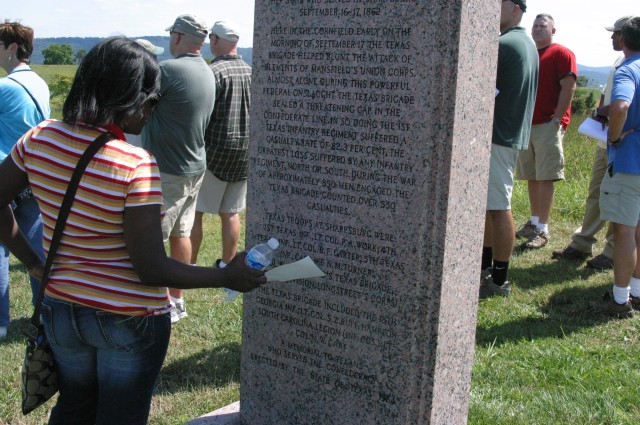Earlier this month, Fort Meade leaders inspected the site where the most American blood was shed in a single day of battle.
A group of installation leaders journeyed to the Civil War battlefield of Antietam for what is known as a battle staff ride in which leadership teams draw lessons from the past.
The trip follows a similar voyage earlier this year to the Gettysburg battlefield in Pennsylvania. While Gettysburg is arguably the turning point in the war between the states, as the North gained momentum, Antietam has its own distinction in American history.
During the battle of Antietam on Sept. 17, 1862, nearly 23,000 lives were lost in a violent clash between Union and Confederate forces. The bloodiest day in American history lasted only 12 hours.
"There's some serious death and destruction happening here," said Navy Capt. Steve Knott, an instructor at the U.S. Army War College in Carlisle, Pa., and tour guide. "It's really a butcher shop here."
The opportunity to learn about the conflict, though, was a thrill for Command Sgt. Maj. Charles Smith, who had recently transferred to Fort Meade's Headquarters Command Battalion after serving in Korea.
"I've been wanting to do this kind of stuff for years, but I've always been in operations units." he said. "[This is] a prime opportunity to learn about it."
The battle came as the Union's Army of the Potomac, a roughly 87,000-strong force under the command of Gen. George McClellan, rushed to confront an invasion of Confederate troops. Days earlier, Gen. Robert Lee had marched an army out of the South to engage and crush the Union army as part of the first Confederate invasion of the North.
Exactly how many troops Lee commanded is unclear, Knott said.
Lee's Army of Northern Virginia was thought to be roughly 40,000 strong, composed of volunteers and militia men who fought to protect their homeland. At the prospect of invading the North, the number of Soldiers who abandoned Lee at the border may have been in the thousands, Knott said.
Regardless of the exact size of Lee's force, he was significantly outgunned against the Union force. However, poor intelligence and the cautious and controlling nature of McClellan would prevent him from using his advantage.
The two sides would fight in cornfields and along rolling hills with gullies deep enough to hide an army.
"I call it the Ph.D. battlefield," Knott said. "You won't find any other Civil War battlefield that has as much nuance."
The battle closed with more than 12,400 Union casualties and about 10,700 Confederate casualties.
The losses, on both sides, struck a chord with Capt. Paul Holt of Fort Meade's Headquarters and Headquarters Company, who organized the trip.
"We shouldn't hold grudges about who fought for which side," he said. "It's always hallowed ground."
After a day of silence and rest for both sides, the Confederates abandoned the field and retreated to the South.
While not a crushing defeat for the South, the North's success at stopping the invasion following several demoralizing losses to the Confederates was a boon for the U.S. government.
Heralded as a victory, it allowed President Abraham Lincoln to issue the Emancipation Proclamation on Jan. 1, 1863.
But to learn of such events from a history lesson couldn't compare to the experience of walking the fields where the battle was fought, said Lt. Col. Thomas Boone of Headquarters Command Battalion.
"I'm a tactile learner," he said. "If I can touch it, it can take me back."


Social Sharing